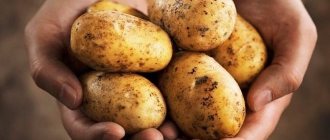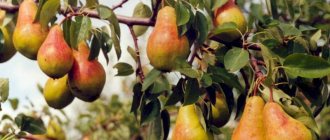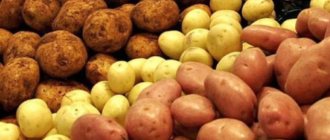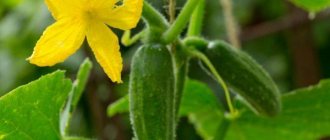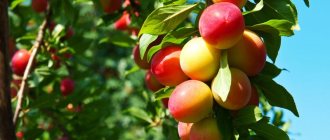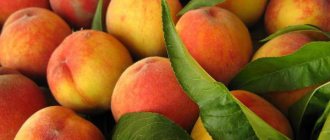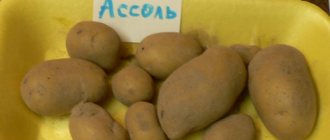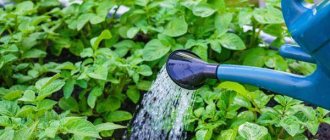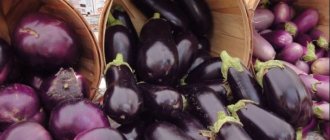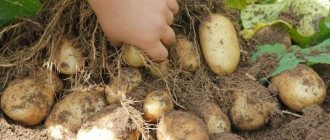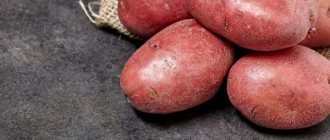Potatoes for the Urals, Sverdlovsk region
Potatoes are a crop that can be grown without problems in almost any region, regardless of its climatic characteristics. The only exception to the rule is the Far North, where the summer is so short that the potatoes simply do not have time to ripen. But in the Urals (in the Sverdlovsk region, Perm region) the cultivation of potato crops is quite active. The only condition for obtaining a good harvest is to take into account the specific climate when planting crops and choose suitable varieties.
Which varieties are considered the earliest in the Russian Federation, depending on the region
Qualitative indicators (yield, starchiness, tuber size, ripening time) depend on weather conditions, soil type and can vary for the same type of vegetable. Thus, Resource grown in the Moscow region contains 11-12% of dry matter, in the Lipetsk region - up to 16%.
For the Middle Band
The regions experience snowy, moderately frosty winters and fairly humid summers with an average temperature of 17-21°C.
Early and ultra-early potato varieties for Central Russia:
Pinkish tubers of the Zhukovsky early variety
For the Moscow region
It is the cyclones and anticyclones that determine what the climate in the Moscow region will be like in the summer. Typically, the amount of warm days and rainfall is sufficient to grow potatoes.
Early potato varieties for the Moscow region:
| Name | Productivity | Consumer properties | Disease resistance |
| Anosta | At the level of 250-300 c/ha. The tubers are regular in shape and medium in size. | Globular tubers with yellow skin and light yellow flesh. The eyes are superficial. Wonderful taste. Starch content - 14-16%. Convenient for cooking chips and French fries. | Does not suffer from nematode disease, leaf curl, or common scab. |
| Bemonda | Maximum yield - 210 c/ha. Tubers are small, 60-76 g. Not in good condition - 4-11%. | Oval red fruit with pale yellow flesh. The eyes are medium. Pleasant taste. Starch content - 10.5-13.5%. | Protected at the genetic level from potato nematodes and late blight on tubers. Shows average resistance to viruses. Susceptible to late blight on leaves. |
| Skoroplodny | With early digging - 15 t/ha. On time - 26-35 t/ha. Potato weight - 60-120 g. | Heat and drought resistant. A very early white variety that does not darken when cut and cooked. | Rarely suffers from late blight and common scab. |
| Pogarsky | 35-45 t/ha. High marketability of tubers. | Starch content - 11-16%. | Has a protective gene against severe forms of viral diseases. |
| Luck | After 2 months - 12-15 t/ha, with mass harvesting - 35-50 t. Potato weight - 120-150 g. | Light beige tubers with small eyes and white flesh. Commercial appearance of tubers - 96-100%. When potassium chloride is added to the soil, the fruits may darken. | Resistant to late blight on leaves and tubers, viruses, scab, and rhizoctonia. Sensitive to Alternaria. |
The Udacha variety is valued for its high yield and resistance to late blight.
For North-Western regions
Late, late spring. Summer is moderately warm, rainy, with an average temperature of +15..+20°C. The total number of sunny days is insignificant. In such conditions, residents of the North-West can only grow early varieties.
The State Register recommends the following for planting in the region:
| Name | Productivity | Appearance and benefits | Disease resistance |
| Felox | At the level of 350-550 c/ha. Tubers are leveled. Not in good condition - 2%. Weight - 90-115 g. | Elongated tubers with yellow skin and pale yellow flesh. The eyes are few in number. Great taste. Starch content - 16-17%. | Nematode resistant. |
| Timo | Maximum variety - 380 c/ha. Tubers are medium-large, 65-120 g. Not in good condition - 10-30%. | Oval fruit with pale yellow flesh. Pleasant taste. Starch content - 14%. | Cancer resistant. Shows average resistance to viruses, late blight, and scab. |
| Karatop | 270-340 c/ha. Potato weight - 60-110 g. | Round tubers with yellow skin. Keeping quality and taste are good. | Resistant to cancer, nematodes, viruses. Relatively to late blight (for early varieties). |
There are many potato varieties with fast ripening times for the Russian climate. Rapid ripening has a number of advantages: early harvest, harvesting before the peak of late blight, good taste, high percentage of marketable tubers.
Climatic features of growing potatoes
The Ural climate is characterized by a rather late arrival of heat. In this regard, potatoes for the Urals, Sverdlovsk region, should be planted relatively late. Frosts on the soil in this region in some years can occur even in June. If you plant potatoes in open ground too early, there is a high risk that they will sprout just during the period of late frosts. If you do not rush to plant the crop, this will not happen.
Experts recommend planting potato planting material in the ground in the second decade of June. Late planting will not only protect the plants from a sudden drop in temperature, but will also give the shrubs the opportunity to grow at optimal temperature and humidity conditions from the very beginning.
Important! Planting varietal potatoes in already warmed soil is an excellent insurance against a number of diseases, including late blight (such conditions are not very favorable for a fungus such as late blight).
In the process of growing potatoes in the Urals, it is recommended to abandon the use of toxic substances. We are talking about poisons used to combat the Colorado potato beetle. Firstly, late planting in itself minimizes the possibility of the appearance of this parasite. By the time the Colorado potato beetle invasion begins everywhere, there are still no seedlings in the late-planted beds. Accordingly, the beetle simply will have nowhere to lay its offspring, and the disaster will safely pass the landing. Secondly, we should not forget that winters in the Ural region are quite severe, the soil freezes to great depths, and in most cases the Colorado potato beetle larvae simply do not survive.
Features of planting and growing
The general agricultural technology for growing potatoes in the Ural zone is practically no different from cultivating the crop in other territories, but still has its own characteristics. They must be taken into account when planting vegetables, otherwise achieving high yields will not be easy.
To do this, you just need to adhere to the following recommendations:
- Light loamy and sandy loam soils with at least 2% organic matter in the composition are suitable for planting;
- the planting area must be fertilized with green manure in the fall; clover and other leguminous grasses are best suited for this;
- in the Urals, potatoes are planted no earlier than mid-May, when the average daily temperature reaches +8...+10°C;
- Before planting, tubers must be vernalized; without this, the emergence of seedlings will last up to 20 days;
- the crop is planted in rows to a depth of 8 cm, with row spacing of at least 1 m;
- For full ripening of tubers, the furrows of the plantings must be directed from north to south.
Features of potato care in the Urals:
| Event type | Optimal period | Basic rules |
| Watering | In the phase of 7–10 leaves, during active budding, during the period of tuber mass gain | The procedure is carried out early in the morning or late evening, each bush is moistened with 12–15 liters of clean, settled water |
| Loosening and weeding | Carry out as needed, after the appearance of weeds, as well as the next day after watering or heavy rains | The depth of loosening should be no more than 3 cm |
| Hilling | In the phase of 3 leaves, 20 days after the first procedure, before flowering, until the aerial part closes | Small hills about 30 cm in height are created around the bushes; if the bushes are planted densely, the rows can be combined |
| Feeding | During budding, during flowering | During the budding phase, the bushes are sprayed with a mixture of 10 liters of water, 2-3 tbsp. l. wood ash and 1 tbsp. l. potassium nitrate. During flowering, the plantings are treated with a solution of mullein (1:10) or bird droppings (1:13) with the addition of 2 tbsp. l. superphosphate |
| Preventative treatments | 14 days after germination, and then every 14 days | Apply a solution of Penncozeb (400 l/ha) or Ditan M-45, (300−500 l/ha) |
The Urals is a difficult climatic region, but growing a high-quality and rich potato harvest within its borders is quite simple. To do this, you need to correctly decide on the variety, and also study its needs in as much detail as possible. Traditionally, the best choice for this area is considered to be early-ripening, frost-resistant potatoes, either table or all-purpose. It is often unpretentious and by the end of summer it can please you with large tubers.
The best varieties for the Urals
Gardening practice shows that not all crops take root in the harsh and changeable climate of the Urals. Therefore, potato varieties for the Perm Territory and Sverdlovsk Region should be selected carefully. Many years of breeding experience have made it possible to obtain a whole range of potato varieties for the Urals, which are capable of producing excellent harvests.
Early, mid-season and universal varieties are most suitable for growing in the Ural conditions. The latter are particularly unpretentious and able to adapt to any climatic conditions.
The following varieties are most often planted in the Urals.
The Gala variety is a mid-early variety of potato. Its growing season varies from 70 to 80 days. The plant is erect, has a medium height, and blooms white. The thickness of the stems is average, the leaves are matte green and quite large, moderately wavy along the edges. Tops growth occurs moderately.
Gala potato tubers are medium-sized (from 70 to 120 grams), oval, with yellow and rather dense skin. There are few ocelli, they lie to a depth of 1 to 1.3 mm.
Interesting. During cooking and other heat treatment, the tubers do not change their color and retain a relatively firm texture.
This varietal potato is considered high-yielding. The average number of tubers in one nest can vary from 10 to 16 pieces. Gala is resistant to mechanical damage, the Colorado potato beetle and most bacterial, fungal and viral diseases. The culture tolerates transportation well and can be stored for a long period of time without losing its external and taste characteristics.
Another good variety for the Urals is Lyubava. This is an early type of potato - its ripening period does not exceed 70 days. One of the most significant characteristics of this varietal variety is its general unpretentiousness. The soil for planting Lyubava can be almost any. Potato bushes are medium height, semi-erect. The plant blooms with purple flowers with a slight reddish tint. The skin of the tubers is red and has medium thickness. The shape of the tubers is oval, the average weight can vary from 110 to 215 grams. The variety belongs to the table variety and is suitable for preparing any dishes. Lyubava potatoes can easily be transported over long distances and can be stored without compromising their taste throughout the winter period. The culture is resistant to most diseases and negative natural factors (drought, temperature changes, etc.).
Governor
Another answer to the question of which potatoes are best to plant in the Urals is the Governor variety. It belongs to the early ones. Its ripening period is no more than 60 days. The bush has medium height and straight stems with wavy wings. The flowering intensity is quite weak. From one bush you can collect more than a kilogram per year. The average weight of tubers varies from 120 to 150 grams. The taste is excellent. Governor potatoes are characterized by high resistance to most diseases typical for the crop and the Colorado potato beetle. The variety is easily transported and stored for a long time.
Article on the topic: Potato variety “Sarov” - description and photo
Despite the fact that potatoes were bred specifically for the Urals, they grow well in other regions that are milder from a climatic point of view.
Exotics of the Urals
When choosing which seed to buy for planting in the Ural region (Sverdlovsk region or Perm region), some gardeners prefer Exotic Ural potatoes. This variety differs from most others in color. Potatoes are blue-violet in color both outside and inside. Moreover, the shade of the tuber does not change even after heat treatment. Those who decide to plant such potatoes are, first of all, those who are attracted by the description of the variety and everything new and interesting. To be fair, it should be noted that the Exotic Ural variety is notable for its shade alone. It has excellent taste and contains many useful microelements and substances: antioxidants, polyphenols, ascorbic acid.
Variety Exotic Ural
The tubers are oblong in shape and medium in size (one potato weighs about 150 grams). This type of potato is productive, stored throughout the winter and tolerates any type of transportation well. The plant is resistant to diseases and parasites.
The Vinetta variety is early ripening. At one time it was selected by German breeders for cultivation in difficult climatic conditions. As a result, this variety of potato is optimal for the Urals. Vinetta is not afraid of drought, has a wonderful taste, and is well transported. The culture matures in an average of 65 days. The number of tubers on one bush usually varies from 10 to 12. The weight of one tuber ranges from 70 to 100 grams. The color of the peel of the variety is yellow, and the pulp is light yellow. The plant blooms with white or pale purple flowers. Various dishes can be prepared from Vineta. These potatoes retain their shape and color even after prolonged heat treatment.
How to choose the right variety?
Today, there are about 4 thousand different varieties of potatoes known on the market, many of which are suitable for growing in almost any climatic conditions. This creates additional trouble for farmers, since not many are willing to spend several years on all kinds of experiments with potatoes. The Ural region is no exception, since the territory often cannot boast of vast areas for effective farming.
Learn about the features of growing potatoes using Dutch technology.
To protect yourself from wasting money when choosing a quality variety, you should consider several rules. The first thing you should pay attention to is the climatic features of the growing area. For cold continental climates, characterized by sharp changes in atmospheric conditions, only frost-resistant varieties are suitable and can withstand prolonged drought.
If potatoes are cultivated in hot summer conditions with sudden changes in temperature, the best will be not only a frost-resistant and super-early variety that can ripen in 40–50 days, since at temperatures above 35°C the tubers complete their formation. Next, you need to decide on the ultimate purpose of using the future harvest. There are fodder, table and industrial potatoes.
Although they look the same, their technical properties are different:
- Feed varieties contain an increased concentration of protein necessary for optimal feeding of domestic animals.
- Technical ones have a high starch content, which is important for their further processing, but do not have a strong taste.
- Canteens are distinguished by a moderate content of starches and a bright, rich flavor, so they are ideal for food purposes.
In addition, there are universal potatoes; such varieties contain high aromatic and nutritional properties, as well as a lot of starch and protein. When choosing table varieties, it is important to consider the ripening time of the tubers. Early ripening varieties are capable of producing the first fruits within 6–8 weeks after planting; this is important in conditions of a limited area, when there is a need to cultivate green manure and other crops.
However, such potatoes often cannot be stored for a long time, and their taste is less pronounced. In the case when you need to obtain a marketable tuber with high taste and nutritional properties, be sure to choose mid-season varieties with a growing season of at least 90 days.
Other varieties
The above names of varieties by no means limit the capabilities of the Ural region in terms of growing potatoes. In addition to them, the following varietal varieties also take root well in the region and produce a good harvest: Balabai, Equator, Sante, Spiridon, Nevsky, Udacha, Alena, Bashkirsky, Spring White, Zhukovsky Early, Skoroplodny, Bullfinch, Bezhitsky, Korona, Lukyanovsky, Oridezhsky, Svitanok Kievsky, Skazka, Effect, Aspiya, Lugovskoy, Belousovsky, Nikulinsky and others. A detailed description of the listed varieties can be easily found on the Internet.
It is strongly not recommended to plant the first potato variety you come across in the Urals. The choice of planting material should be approached with all thoroughness. After all, in the end, the future harvest largely depends on the correctness of the chosen variety. This is especially true for the Urals, where the climate is neither mild nor stable.
Types of varieties
Varieties can be classified into 4 types:
- Seed . It is a seed planting material for the future potato harvest. Recommended for cultivation in summer cottages. They are characterized by a starch content of 12-17%.
- Early . The ripening period is 50-65 days. They are ready for consumption before anyone else and are divided into subspecies depending on the timing of ripening: early ripening, early ripening, mid-ripening.
Early potatoes are good for eating during the summer, as they generally do not tolerate winter well and are unable to store moisture. They are characterized by rapid growth and a short growing season.
- Mid-season . The ripening period is 85-95 days. A more unpretentious variety and better stored than the early variety. The crop is harvested in early August. It is considered a fairly unpretentious variety with excellent taste.
Potatoes can also be distinguished depending on their purpose:
It’s not without reason that they say: potatoes are the second bread, because this crop is grown everywhere in our country - from Kaliningrad to Kamchatka. Experienced gardeners in Siberia and the Urals, thanks to the variety of varieties, have learned to obtain an unprecedented harvest of early, mid-season and even late potatoes.
The best potato varieties for the Urals
A sign of successful potato growing is a rich, high-quality harvest. Achieving this is not at all difficult if the summer resident takes into account the characteristics of the soil, regional microclimate, and ensures timely processing of the beds (hilling up, weeding, fertilizing). There is another important factor - the selection of the appropriate potato variety. For the Urals this is of paramount importance, since this region is located in three climatic zones at once. The so-called agricultural zone of the Urals includes 4 regions - Chelyabinsk, Kurgan, Perm, Sverdlovsk. The weather conditions here have their own characteristics.
In the description of potato varieties for the Urals one can often find such a characteristic as frost resistance. This should be taken into account when choosing varieties, since a heat-loving plant is not suitable for this agricultural region. Due to the short duration of the warm period, many summer residents recommend choosing early potato varieties. There is a wide range of this vegetable for the Urals, so every beginning gardener will be able to choose exactly the one that will meet all his requirements.
Potatoes without any fuss
In the spring, when everything dries out (i.e., around mid-April), we again pour two buckets of compost onto the beds (but without ash), sprinkle them with microbiological fertilizer and loosen them with a flat cutter.
And after two weeks, when the soil has warmed to a depth of 8-10 cm, you can safely begin planting. Here I want to make one important digression regarding the preparation of tubers. A month before planting, we bring them from the cellar and soak them for 10 minutes to prevent scab.
in a urea solution (200 g per 10 liters of water), and then for 2 hours we place them on burlap and cover them with it on top. After that, we again put them in boxes by variety and expose everything to diffused light. For the first 20 days, we spray the tubers with solutions of humates (1 tablespoon per 10 liters of water) and sprinkle them once with sifted ash. 10 days before planting, we place the seed material on sawdust treated with urea since the fall and cover it with a small layer on top. We moisten this whole “pie” with water two or three times.
When the time comes to plant the tubers in the ground, you take them out of the sawdust - and they already have such beautiful roots-beards that your soul rejoices!
We carry out the planting work itself quickly. We mark the holes along a stretched cord, making them at intervals of 30 cm - everything turns out smooth and beautiful. Planting depth – 8 cm (taking into account future hilling). We do not use any fertilizers at this time: the soil is already filled with everything necessary in advance and is very loose (there are apparently no worms in it). On the sides of the potato beds on the same day I also plant black beans - five to six seeds in each nest and always flat.
When the shoots appear (and this will happen in 15 days), we dilute 1 tbsp in 10 liters of water. l. liters of calcium nitrate and spray the sprouts. If frosts are expected, we either urgently hill up the potatoes (combining this with dusting with ash), or cover the rows with non-woven material.
Usually my Boris Vasilyevich carries out this procedure twice. The first is when the height of the bushes reaches 15 cm. If the soil is dry, then the night before I water it well. My husband does the hilling itself so that in the center of each of our narrow beds it looks like a groove into which we then pour water during watering.
Boris Vasilyevich carries out the second hilling before flowering. And again, the day before, I do a little preparatory work: this time I fertilize the potato plantings with a solution of potassium sulfate (1 tablespoon per 10 liters of warm, about 40° water) or monophosphate. And I do exactly the same feeding two weeks after flowering. Well, of course, I pick off the flowers. This is not difficult for me to do, since the area under potatoes is only 0.72 acres.
If the weather is too hot, so that the tubers do not stop growing, we water the potatoes by sprinkling and cover the beds with the thinnest agrofibre. And if the summer is rainy, then we don’t water at all. We don’t always cut off the tops; we dig up the harvest before August 15th. Well, then everything starts again, as already described above.
That’s all our potato agricultural technology, which we have been adhering to for several years now. I wish all gardeners, vegetable gardeners and flower growers to enjoy life, every plant that comes up, and not to be upset if something doesn’t work out. We, summer residents, are stubborn people, which means we will still achieve success. And difficulties are given to us only to provoke us in a good way.
Potato varieties for the Urals: photos and descriptions
- Riviera . The peculiarity is that, under certain conditions, it is possible to harvest twice in a season, but this is only possible if the household is located in a temperate climate zone. It is for this region, according to gardening experts, that the Riviera is ideal. The tubers have a light yellow tint, a slightly rough surface, and a thick skin. There are very few eyes on the fruits and they are not deep. The shape of the fruits looks like an irregular oval, quite large. Best suited for consumption (both in terms of taste and complex of nutrients). Riviera potatoes can be stored very well and for a long time.
- Zhukovsky early . This is the fruit of the work of Russian breeders. Designed for weather conditions of the Ural region. You can recognize this vegetable by its external characteristics - the peel is pale pink, with reddish eyes, and it covers the white flesh of the round oval fruit. According to many summer residents, this is the best potato variety for the Urals. Reviews say that experienced summer residents harvest up to 350 kg of crops from one hundred square meters. Absolutely all types of soil are suitable for its cultivation. It does not require frequent watering and special care.
- Ariel. An early-ripening table potato variety for the Urals of the Dutch selection. Perfectly adapted to the climatic zones of this region. The tubers have a round or round-oval shape. The peel is light white and the flesh is creamy. The first fruits can be obtained already on 45-50 days. Ariel is considered one of the most productive potato varieties for the Urals. This category can also include Rocco, Colombo, Tiras, Lugovskoy, Bella Rossa.
- Timo . It is famous for its early ripening and taste. This is the development of Finnish breeders. According to its characteristics, it is suitable for any climatic zone of the Urals. It has frost-resistant qualities and excellent resistance to many common diseases (powdery mildew, late blight, alternaria). The tubers are characterized by a round-oval shape, white thin skin, and have an excellent taste. The flesh is light cream. It is recommended to increase the yield of this wonderful, one might say the best, potato variety for the Urals using organic fertilizers (compost or well-rotted manure), in combination with superphosphate.
Article on the topic: Potato variety “Agata” - description and photo
In addition to the above, you should also pay attention to a number of unpretentious, productive, best varieties of potatoes (see photo) for the Urals:
- Vinetta.
- White Spring.
- Governor.
- Lyubava.
- Ermak.
- Gloria.
The best potato varieties for the Southern Urals:
- Precocious.
- Bashkir.
- Luck.
- Impala.
The best potato varieties for the Middle Urals:
- Idaho.
- Rosara.
- Gala.
- Tuleevsky.
- Picasso.
- Lorch.
Universal, best potato varieties for the Urals (and Siberia as well):
- Nevsky.
- Radonezh.
- Anosta.
- White Night.
Description and photos of varieties
Average
- Nevsky. Has an average yield. The peel is beige, the root itself is white inside. Resistant to cancer and golden nematode. Has good keeping quality. Ripening period is 80-90 days.
- Gala. A distinctive feature is significant productivity. Elongated oval tubers, yellow skin and pulp. Resistance to mechanical damage, potato cancer, nematode. Ripening period is 65-80 days.
- Treasures Mid-season. It is characterized by high productivity and unpretentiousness. The tubers are oval, yellow skin and pulp. Resistant to potato cancer and golden nematode, banded mosaic. Reaches full maturity in 80-95 days.
- Naiad. Medium and high yield. The tubers are oval in shape, with small eyes. The peel is yellow, the flesh is white. Resistance to potato canker, golden nematode and late blight.
Photos of potato varieties.
Early
- Spring is white. The variety is characterized by high yield and early ripening. Tubers ripen on average in 60-70 days. The tubers are white, oval-shaped, with small eyes. Resistant to rhizoctonia, alternaria, scab. Sensitive to late blight.
- Zhukovsky early. Very early. Average yield. Pink tubers, white flesh. Resistance to mechanical damage, arid climate, cancer, golden nematode. Ripening: 70-80 days.
- Bellarosa (White Rose). This variety is characterized by good yield and unpretentiousness. The color of the peel is red, the cut is light yellow. Ripening occurs in approximately 70-80 days.
Late
- Belousovsky. Medium-yielding. The peel has a yellow tint, the root itself is white. Tolerates viral diseases well. The growing season is 95-110 days.
- Lorch. Ripening time is 100-120 days. The skin is yellow, the inside is creamy. High and medium yield. Tolerates mechanical damage well.
- Nikulinsky. The rind is yellow, the inside is creamy. The ripening period is 95-110 days. Resistant to viruses and mechanical damage. Does not tolerate drought and late blight.
Nikulinsky:
- Svitanok. Versatile, high yield. The skin color is pinkish, the core is creamy. Fully ripens in 85-105 days. Excellent germination.
- Luxury It has a red skin and yellow inside. The tubers are elongated-oval. High yield, ripening occurs in 65-70 days.
Elite
- Baron. Almost perfect variety. It is considered one of the best for the Urals. Excellent taste, suitable for preparing any dishes. Excellent keeping quality. Resistant to all diseases except scab.
- Luck. This potato fully lives up to its name and is very popular due to its main feature - adaptability to any climatic conditions and excellent yields regardless of them. Well kept. Resistance to diseases, infection by viruses is extremely rare.
- Rosara Elite. A very competitive variety, not only on the domestic market, but also on the world market. Good yields in any conditions. It is unpretentious in cultivation and does not lose its taste or commercial qualities during storage. Doesn't get soft when cooked. It has an excellent taste and is highly valued in cooking.
The most productive
Some of the varieties described above fall into this category:
- Gala (yield up to 700 c/ha).
- Treasures (up to 650 c/ha).
- Meteor (up to 550 c/ha).
- Svitanok (up to 560 c/ha).
- Rosara. Early. Tasting rating – 5 points on a five-point scale, has a pleasant, mild taste without excessive cloying or sweetness. The pulp is not watery. Most suitable for frying. It easily adapts to the climate and can withstand long-term transportation and mechanical damage. Moderately resistant to scab and late blight. Ripening: 50-65 days.
- Picasso. It has excellent taste, tasting score – 4.5 points. Due to its low starch content, it does not boil over, which makes it suitable for preparing various dishes. Suitable for salads and frying. Tolerates drought and high temperatures. Susceptible to most viruses, resistant to other diseases. Growing season 110-130 days.
- Rodrigo. Mid-early. Wonderful taste, rating 4.5 points. Does not lose its taste during storage. Ideal for boiling and making purees. The peel is pink, the root itself is yellow. Average resistance to viruses and diseases.
Rodrigo:
- Aurora. Mid-season, with excellent table qualities. Starch content 13-17%. The skin color is beige, yellowish in cross section. Moderately susceptible to late blight.
- Sineglazka. It got its name because of its original coloring. The skin is creamy with purple spots (eyes). High-yielding, has good taste. Starch content from 15%. Early ripening, ripening 65-80 days. Average resistance to almost all diseases. The variety is not for storage; if left for a long time, it begins to rot.
- Lugovskoy. Starch content 12-19%. One of the most commonly used varieties for making starch. Stable good yields, adaptability to climatic conditions. The tubers are pink, white in cross section. Ripening: 70-80 days.
- Riviera. Ultra early. Ripens in 40-80 days. Tolerates drought and heat well. Starch content 12-16%. It is prone to scab; it is better not to delay cleaning it; in this case, it often gets sick with late blight.
Riviera:
- Vector. It was entered into the State Register of the Russian Federation relatively recently - in 2014. High-yielding. The pulp is dense, light yellow. The skin is red. Ripens in 80-100 days. Susceptible to nematodes and late blight.
- Charoite. Very early. One of the main features of "Charoit" is that it can be planted within 5-7 years of the previous harvest. Every year the quality and taste characteristics of the harvest increase. Medium-yielding. Root vegetables are yellow. Moderately resistant to potato viruses and diseases, but very susceptible to damage by various types of nematodes.
- Granada. It was introduced in 2015. It is universal and can be grown in any region. Super-yielding, medium-late. Root vegetables are light yellow. Resistant to almost all nightshade diseases and viruses.
The following varieties are suitable for cultivation in the Southern Urals:
- Zhukovsky early.
- Spring is white.
- Belousovsky.
- Lorch.
- Nikulinsky.
- Lugovskoy.
- Nevsky.
- Santa.
- Svitanok.
Late ones are not recommended.
Now it will not be difficult for you to choose the best varieties for planting that are suitable for growing in your region. You can choose those that seem most attractive to you based on their distinctive features and characteristics.
New potato varieties for the Urals
Breeders do not tire of working to constantly improve the quality characteristics of potatoes for the Ural regions. As a result of fruitful work, new varieties appear. They are quickly becoming popular (modern information technologies contribute to this in the best possible way).
Of the new varieties, preference should be given to:
- Burnovsky . Mid-early, table light beige potatoes. Those who have already grown it in their garden plots appreciated the tender, crumbly pulp of the vegetable. The variety turned out to be quite productive (about 200 c/ha). It has many qualities, including resistance to disease and ease of care.
- Bullfinch . One of the most frost-resistant types of potatoes. Designed for cultivation in the Northern Urals. It belongs to the early ones. It has a pink peel, light white flesh, and an oval shape. The weight of one fruit does not exceed 1/10 kilograms. It is very good to store in positive temperatures (up to 10 0 above zero).
- Rosara Elite . We can safely include elite potato varieties for the Urals in this group. Main characteristics: frost resistance, disease resistance, excellent taste, productivity. Ripening time is measured in two months from the moment of planting in the soil.
You should also pay attention to such new varieties as Red Lady, Felox, Baron.
Many summer residents note that growing this wonderful vegetable is not at all difficult. This is true. But, nevertheless, it should be remembered that in order to reap a bountiful harvest, it is necessary to purchase the appropriate variety.
The most productive varieties for the Sverdlovsk region and Perm region
Below are the most highly productive varieties of potatoes. For those who choose the best and most delicious potatoes, the description of the variety for the Urals is of great importance. Only knowing the characteristics of specific species can we draw a conclusion about the need to grow a particular variety.
Gala
The Gala potato variety for the Perm region has an excellent taste. When cooked, it retains its shape, so it is suitable for salads, frying, and making French fries. Chips are also made from it.
One of the most delicious dishes is whole potatoes boiled and then fried.
Gala is an early variety that ripens in 80 days. The peel is red, the fruits themselves are oblong, and the flesh is yellowish. The eyes are set shallowly, so they are easy to cut out. Starch is contained in a proportion of 12-16%.
For reference! From one hundred square meters of land, summer residents often collect 200-320 kg of tubers.
belongings
The variety is classified as mid-season; it is distinguished by its resistance to damage and ease of care. The growing season lasts 80-90 days. The bushes grow to medium size and are strong.
The skin of the tubers is light golden, smooth, and the pulp does not boil over. The eyes, evenly distributed over the surface of the fruit, are shallow. One culture produces about 12-18 fruits. They weigh about 200 grams. Oval potatoes are strong and resistant to mechanical stress.
What kind of potatoes can be grown in Siberia and the Urals
Properly selected varieties depending on the climate of the region guarantee productive beds. Knowing the features of time-tested potatoes and analyzing reviews of new products, you are less likely to get into trouble with the harvest. I would like to highlight those varieties that differ significantly in their performance from other more well-known ones.
Potato varieties with a short growing season
Charoite is a new forty-day variety, the first harvest of which can be obtained already on the 40–45th day. Return - up to 380 c/ha. Potatoes with heavy tubers (up to 140 g), smooth light skin and a yellowish center contain 17% starch; when cooked, the flesh remains tender and does not crumble. The variety is susceptible to nematodes, but rarely suffers from late blight.
Early ripening Charoite allows gardeners to experiment and get two harvests per season
Meteor is an ultra-early variety that has been pleasing gardeners for more than 10 years. The growing season is 45 days. The skin is ocher, rough; the flesh is rich yellow. Unlike Charoite, it has a higher yield - almost 450 c/ha (up to 6 kg per bush). The mass of tubers of these varieties is the same, but Meteor is 3% inferior in starchiness - you can bake it “in their uniform” and put it in salads. They love him for his endurance - he rarely gets sick and keeps up well.
Meteor's tubers are not large, but there are more than 10 of them in a bush
In comparison with other early varieties for the northern regions and the Urals, Karatop has an amazing yield - up to 500 c/ha. Viral diseases bypass this variety; potatoes are stored until spring. Tubers (100 g or more) with yellow skin and the same pulp contain no more than 14% starch - a classic potato for first and second courses.
Early Karatop is perfect for the unstable Siberian climate
Bashkir is an early ripening variety cultivated in the Ural region. It has a high yield - more than 480 c/ha. Large pink-sided tubers with yellowish flesh weigh on average almost 200 g. The cultivar with a high starch content (about 20%) has good shelf life. Bashkirsky’s immunity is not very resistant to viruses and diseases.
Bashkir was bred more than 10 years ago specifically for cultivation in the Urals
Mid-season potatoes
In Memory of Rogachev, record yield figures for mid-season varieties are 522 c/ha. Rough pale yellow tubers with light flesh (starch content more than 20%) gain almost 160 g. Potatoes do not suffer from cancer and scab; if stored properly, they last until mid-spring.
Article on the topic: Potato variety “Nalchik” - description and photo
The Memory Rogachev variety is quite starchy, it will be appreciated by those who love boiled and baked potatoes
The weight of Lazar potato tubers is the same as that of the previous variety, and the amount of starch exceeds 23%. These potatoes are good to put in casseroles and make mashed potatoes from them. On average, one bush produces up to 4.5 kg of red-pink tubers with snow-white pulp. The cultivar is susceptible to nematodes, but is rarely affected by late blight and leaf curl.
Pink-fruited Lazarus, according to reviews from summer residents, is very aromatic and tasty
The Zlatka potato received its name for its bright yellow tubers with beige pulp (18% starch). On average, ripe tubers weigh 120–160 g. The variety has an excellent yield for the Siberian climate - 460 c/ha, and is highly resistant to many diseases.
Zlatka potatoes are highly marketable
Many summer residents living beyond the Urals choose the Irbitsky variety: the tubers are light-colored, large - 160-180 g each, with a red smooth skin and a starch content of approximately 16.5%. This potato is not afraid of nematodes, cancer, and striped mosaic. The variety fits well in the vegetable storehouse and bears fruit abundantly (yield - 468 c/ha).
Irbitsky has large oval tubers with rough skin
Late potato varieties for the Urals and Siberia
Lugovskaya has been known for almost half a century; thanks to its good taste and high yield (more than 500 c/ha), this variety has become the leader among late varieties in the Urals and Siberia. Potatoes have oval tubers with pinkish smooth skin (weight 125 g) and white pulp with a low starch content of 12%. It was ranked among the first for its high immunity to late blight, blackleg and scab. Potatoes with late ripening
Lugovskaya has been cultivated for many years in most regions of our country.
Mustang is recognized as the best late-ripening variety in Eastern Siberia. The cultivar with oval, ruddy fruits (100–150 g each) and appetizing yellow pulp contains about 19% starch; when cooked, the pulp becomes loose, but does not soften. Productivity is within 380 c/ha, the variety is resistant to wrinkled mosaic and cancer.
Pink Mustang tubers hardly crack when baked
White-fruited Nikulinsky is loved for its yield (more than 400 c/ha) compared to other varieties with a long growing season. The advantage of the variety is 21% starch. The weight of the tubers ranges from 70 to 135 g. Nikulinsky is good both boiled and stewed, and for baking. The variety is perfectly stored until summer and is slightly susceptible to viral diseases.
Snow-white Nikulinsky pulp does not darken when cut
For the Urals, according to reviews of local gardeners, among the late varieties it is impossible to find better than Belousovsky. The round, whitish tubers with the light flesh typical of potatoes are not large (about 90 g), but the yield of one bush reaches 6 kg. Potatoes contain up to 19% starch. The variety tolerates drought well and is rarely affected by late blight.
Belousovsky potatoes ripen later than others and are stored until the end of spring
Table: other potato varieties for the Ural region and Siberia
The most delicious potatoes
When choosing a potato variety, you should focus on the geographical location and climatic conditions of the area where the crop will be planted.
You should also consider what kind of harvest you want to get - early or late. Let's look at the most popular potato varieties for the Middle Urals - Chelyabinsk region and others. The Middle Urals are characterized by a temperate climate and high humidity. There are no severe frosts in the area, but summers are also without heat. The average temperature in winter is -10, -15 degrees, and in summer up to 10, 20. Warmth begins at the end of spring and continues until the beginning of autumn. It is better to plant the following varieties in the Urals.
Governor
Early, with reddish skin of tubers and lemon pulp. It tolerates transportation comfortably and is famous for its high yield (2 kg per bush). Contains up to 14% starch. The ripening period is 2 months; at the beginning of summer you can try the first new potatoes.
The average tuber weight is 100-150 g. One hundred square meters yields up to 250 kg of root crops. Tolerates illness well.
Governor
Balabay
Mid-season, brings harvest in the third month of summer. The skin is red, the pulp is lemony. Resistant to heat and excess moisture. Contains up to 14% starch.
Designed for table use. The ripening period is 90-100 days. Sowing takes place in mid-May. Potato weight 120-140 g.
Equator
Mid-season, you can try new potatoes in mid-July. The fruits reach 100-120 g, the skin is pink-red, the flesh is light beige. Potatoes boil well due to their high starch content of up to 20%. The ripening period is 90-100 days.
Medium early, ripens in 80-90 days. The yield per acre is 300 kg, up to 20 fruits per bush. Weight reaches 120-150 g. The skin is yellow. Contains a small amount of starch 10-12%, so the potatoes do not get soft when cooked. The variety contains amino acids and trace elements, a large amount of vitamin B.
Spiridon
Mid-season, has a crimson-red skin. Weight reaches 110-150 g. Starch in the variety is about 12-15%. Not prone to diseases.
Spiridon
Nevsky
Early, young potatoes can be tasted 40-50 days after germination. The entire growing season is 65 days. The variety is considered one of the most productive. The skin color is lemon, the flesh is white.
The advantage of the Nevsky variety is that it does not darken when cleaned. One bush produces up to 15 tubers. The average weight of one is 90-120 grams. It tolerates late blight well, although it does not tolerate viral diseases well.
Nevsky
Early ripening, one of the first to appear on sale. The skin is dark lemon color, smooth to the touch with reddish eyes. Contains up to 12-14% starch. The pulp is light, yellowish when cooked. The average weight is 120-150 g. The harvest depends on climate and soil.
Early, ripens within 60-70 days. Contains a high level of starch 15-17%. It has a pinkish peel and white flesh. Weight 80-160 g. Weakly tolerates nematodes and late blight. Tolerates heat and drought well.
Bashkir
https://www.youtube.com/watch?v=gVYxFQvqNfI
Early ripening, bears fruit in 1.5 months. The entire ripening period takes 60-80 days. The skin color is scarlet and pink. The advantage of the variety is that it is difficult for the Colorado potato beetle to cling to the leaves of the plant.
The weight of one is 90-150 g. Up to 10 fruits can form on a bush. The yield per hectare is 150-250 kg.
Spring is white
Ultra early, appeared in 1994 through a 3-species hybrid mutation. The skin is muted lemon, the fruit inside is white. Root weight 80-140 g. Does not tolerate viral diseases and late blight.
You can get up to 15 tubers from one bush. Contains 12-16% starch. Stores well in winter and withstands transportation.
Spring is white
Vineta
Vineta is a universal variety in terms of early ripening. The skin is yellow, the inside is white. Weight of potatoes 70-90 g. Contains 12-15% starch. One bush can produce up to 12 root crops. Full ripening period is 70 days.
The first harvest after germination can be obtained on the 50th day. Suitable for long-term storage, resistant to diseases.
Vineta
Zhukovsky early
Early, with smooth pink skin, white inside. Contains up to 15% starch. It tolerates diseases well: scab, nematode, cancer. They do not tolerate fungal and infectious diseases well. From one bush you get up to 1.5 kg. Ripens within 60 days.
Zhukovsky early
Lyubava
Early, stored for 7 months. The ripening period is 60-80 days. Weight 150 gr. Productivity up to 500 kg. The skin is light scarlet, the inside is white.
Lyubava
Skoroplodny
Early ripening. Ripening time is 60-70 days. The skin is yellow, the inside is white. Weight 60-120 gr. Contains 12-17% starch. Productivity per 1 hectare is 350 kg.
Bullfinch
Early ripening, with light scarlet skin, creamy inside. Weight is 60-90 g. Contains 16-18% starch. Ripening time is 50-60 days. The average yield per 1 hectare is 300 kg. The variety is well resistant to potato blight, blight, viruses, and late blight.
Bullfinch
Medium early, has an oval-round shape. The peel is pink-red, the flesh is creamy, and does not darken when peeled. The average weight of the root crop is 70-110 grams. May become infected with scab. Full ripening period is 70-90 days.
Crown
Medium early with dark lemon skin, white inside. Potato weight 70-130 g. Contains 13-15% starch. Does not suffer from nematodes or cancer. There are risks of contracting late blight. Productivity up to 270 kg of potatoes.
Crown
Lukyanovsky
Medium early, delicate lemon shade, white inside. The ripening period is 70-80 days. Weight reaches 90-150g. It tolerates drought well, is easily transported, without damage.
Oredezhsky
Medium early, yellow, white inside. Root weight 80-140 g. Contains a starch level of 13-15%. From one hundred square meters you can harvest up to 300 kg of potatoes. Perfectly preserved in winter. Resistant to late blight.
Oredezhsky
Svitanok Kyiv
Medium early, has proven itself in the Urals. Tubers weigh 90-120 grams. The potatoes are smooth, the skin is reddish, and the inside is white. Contains a high percentage of starch 19%.
From 1 acre you can harvest up to 300 kg of potatoes. The harvest is harvested closer to August.
Svitanok Kyiv
Fairy tale
Mid-early. The average weight of tubers is 70-130 g. The skin is red with pink eyes, the inside is white. You can get up to 25 fruits from one bush. The variety prefers loamy and sandy soils. Does not like excess moisture. Contains 14-17 starch.
Fairy tale
Effect
Mid-early. Muted lemon shade, white inside. Contains 12-15% starch. Average weight 80-120 g.
The Effect potato variety easily tolerates many diseases, but still requires preventive protection with chemical solutions when planting. It is well stored in winter and transported well.
Mid-season, with a ripening period of 80-100 days. The roots are light yellow, white inside. Average weight 70-120 grams. starch 12-14%. Needs protection from late blight when planting.
Lugovskoy
Mid-season, with a ripening period of 70-95 days. The skin is pink, the flesh is white. Average weight 100-130g. Contains 12-19% starch. Tubers are rich in proteins, vitamins, and amino acids. Well resistant to diseases.
Lugovskoy
Belousovsky
Medium late, ripening period 100-110 days. It has a light yellow tint, white inside. Potato weight 80-100 g. Contains 18-19% starch. Resistant to drought and heat. It tolerates viral diseases well and is moderately resistant to scab.
Medium late, with a ripening period of 100-120 days. The skin is yellow, the inside is creamy. Potatoes weigh 90-120 grams. You can collect up to 1 kg of root vegetables per plant.
The variety is moderately resistant to root rot, late blight, and scab. With a lack of calcium and fluoride, they can stretch out.
Nikulinsky
Medium late. The skin is yellow, the inside is creamy. Contains 15-20% starch. The average weight of the root crop is 70-120 g. The fruits do not darken when cut. Does not tolerate late blight well and needs protection when planting.
Nikulinsky
Varieties can be classified into 4 types:
- Seed. It is a seed planting material for the future potato harvest. Recommended for cultivation in summer cottages. They are characterized by a starch content of 12-17%.
- Early. The ripening period is 50-65 days. They are ready for consumption before anyone else and are divided into subspecies depending on the timing of ripening: early ripening, early ripening, mid-ripening.
Early potatoes are good for eating during the summer, as they generally do not tolerate winter well and are unable to store moisture. They are characterized by rapid growth and a short growing season.
- Mid-season. The ripening period is 85-95 days. A more unpretentious variety and better stored than the early variety. The crop is harvested in early August. It is considered a fairly unpretentious variety with excellent taste.
Universal varieties - can be table, technical and fodder and perform any task. They have a thick peel and are usually suitable for long-term storage and are suitable for frequent transportation.
Potatoes can also be distinguished depending on their purpose:
- stern The root vegetable is large in size and contains a large amount of protein;
- food Sown in government fields for sale and use in government agencies;
- technical. Used for the preparation of alcohol products;
- universal. Has a wide range of uses.
| Seed | Early | Mid-season | Universal |
| RivieraCarlenaVegaInara | GovernorNevskyAlenaZhukovskyLyubavaEffectBullfinch | BalabayEquatorSpiridonLuckBashkirSkoroplodnyBezhitskyCoronaLukyanovskyOderezhskySvitanok KievFairytaleAspiyaLugovskoy | LuckVinetaBelousovskyNikulinskyLorch |
The variety of varieties allows you to calmly choose the variety you need to grow based on its characteristics
The future harvest depends on the choice of potato variety, so you should carefully consider planting seeds. This is especially true for the middle Urals, where the climate is not as stable as in the south. Have a rich harvest!
Many people associate the onset of warm days after a long winter with picnics in nature, but not among gardeners and summer residents. For them, changes in weather conditions for the better mean the onset of planting work, and not only that.
One of the most popular crops grown is potatoes. It is unpretentious in care, but its yield will depend on the variety.
Which potato variety is best? This question is asked by every gardener who dreams of a big harvest, and at the same time wants to save his energy when growing crops.
